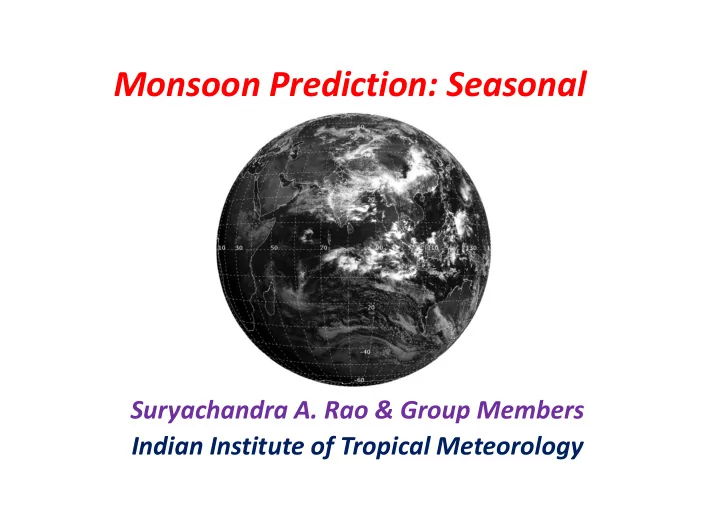

Monsoon Prediction: Seasonal Suryachandra A. Rao & Group Members Indian Institute of Tropical Meteorology
DEFINITIONS OF METEOROLOGICAL FORECASTING RANGES 1. Nowcasting A description of current weather parameters and 0 -2 hours description of forecasted weather parameters 2. Very short-range weather forecasting Up to 12 hours description of weather parameters 3. Short-range weather forecasting Beyond 12 hours and up to 72 hours description of weather parameters 4. Medium-range weather forecasting Beyond 72 hours and up to 240 hours description of weather parameters 5. Extended-range weather forecasting Beyond 10 days and up to 30 days 6. Long-range forecasting From 30 days up to two years
Two kinds of Atmospheric Predictability Predictability of 1st kind Originates from Initial condition Deterministic forecast fails beyond two weeks due to the growth of errors contained in the initial states. Chaotic behavior of atmosphere comes from its strong non- linearity. Predictability of 2nd kind Originates from lower boundary condition Effective for longer time scale; Month to season
Relative importance of Initial Condition and Boundary Condition Initial Condition Boundary Condition Importance Predictability of 2nd Predictability of 1st kind kind 1-Month 3-Month Hour Day Week Month Season Year Average Time Scale Intra-seasonal Oscillation Meso Typhoon Global Warming ENSO Tropical disturbances
Lower Boundary Condition of Atmosphere ◎ Ocean Sea Surface Temperature (SST) Sea Ice Most IMPORTANT to the ◎ Land Surface atmospheric Soil Temperature variability ! Soil Moisture Snow Cover, Snow Depth Vegetation ( Grass, Tree etc. )
Walker’s Contributions • Sir Gilbert Walker made significant contribution to long range forecasting research. • He introduced the correlation and regression techniques and objective models. • His research for global predictors led to the discovery of Southern Oscillation and North Atlantic Oscillation. • His regression methods have been more or less followed by IMD for the operational work.
IMD Operational Model Prediction Skill of ISMR Wang et al., (2015; Nature Communications)
Two Methods for Numerical Seasonal Prediction Past Present Two-Tiered Way One-Tiered Way Atomosphere-Land Atmosphere-Land-Ocean Coupled Coupled Model Model Atmospheric Model Separately predicted SST Ocean model is coupled is prescribed as boundary
Monsoon
Indian Monson and Agriculture
Two-tier MME hindcast of summer Monsoon rainfall Hindcast Skill is nearly Zero in ASM region 5-AGCM EM hindcast skill (21Yr) • Two-tier system was unable to predict ASM rainfall. •TTS tends to yield positive SST-rainfall correlations in SM region that are at odds with observation (negative). •Treating monsoon as a slave to prescribed SST results in the failure. OBS SST-rainfall correlation Model SST-rainfall correlation Wang et al. (2005)
STATE OF THE ART COUPLED MODELS PREDICTION SKILL (Correlation between observed and Predicted) OF TROPICAL PRECIPITATION (Prior to Monsoon Mission) Preeti et al., (2009) Rajeevan et al., (2011)
IMD Operational Model Prediction Skill of ISMR Wang et al., (2015; Nature Communications)
CC=0.39 Dynamical AGCM Potential Prediction Skill Gadgil & Sreenivasan, (2012) CC=0.45 Dynamical CGCM CFS Prediction Skill (T62L64) Rajeevan (Pers. Communication) & Pattanaik and Arun Kumar (2014)
Major Biases in CFSv2 Main Biases: Dry bias over India Cold bias in SST Cold land and trop. Temperature Excess Eurasian snow Excessive convective rainfall over tropics Saha et al., (2013)
Attempts to reduce these biases • Convective Parameterization (New SAS, Han & Pan, 2011; Ganai et al., 2014) • Cloud Microphysics (Hazra et al., 2015; Abhik et al., 2016 communicated) • Super Parametrization (Goswami et al., 2015) • Improved snow physics in Land Surface Model Saha et al., (2016. to be submitted) • High Resolution Model (Ramu et al., 2015) • Stochastic Parametrization (in progress) • New Ocean model (in progress)
Importance of High Resolution
Observed rainfall GFDL CM2.1 2 ° Atmosphere 1 ° Ocean GFDL CM2.3 1 ° Atmosphere 1 ° Ocean GFDL CM2.4 1 ° Atmosphere 1/4 ° Ocean GFDL CM2.5 1/2 ° Atmosphere 1/4 ° Ocean Courtesy: Gabriel Vecchi (GFDL)
Enhanced Resolution and Coupling Improve Monsoon Representation Courtesy: Gabriel Vecchi (GFDL)
IITM CFS Model: Seasonal Prediction Atmospheric Model ATMOSPHERE INITIAL GFS CONDITIONS FROM GSI (NCMRWF) T382 L64 levels Land Model Ice Model NOAH COUPLER Ocean Model OCEAN INITIAL CONDITIONS MOMv4 FROM GODAS (INCOIS/IITM) global 1/2 o x1/2 o (1/4 o in tropics) 40 levels Initial conditions for Hindcast runs are obtained from CFSR (Original model is adopted from NCEP)
SST/Rainfall Bias in T126 and T382 Ramu et al., (2016, JGR)
Ramu et al., (2016, Submitted)
Ramu et al., (2016, Submitted)
T382L64 Skill of Rainfall/SST GPCP VS T382 ERSST VS T382
Monsoon Mission Model Performance (Prediction Skill as well as interannual variance) is better than other models for Indian Monsoon.
Prediction Skill of Monsoon Rainfall in 5 Homogenous Regions ISMR Skill (correlation between model JJAS rainfall and observation rainfall) for all the homogenous regions over India. Green colour indicate indicates 95% confidence level. February IC during 1981-2008. Region T126 (≈100km) T382(≈38km) Central North East Indian 0.43 0.22 (CNEI) North East India (NEI) 0.45 0.08 North West India (NWI) 0.41 0.21 West Central India (WCI) 0.22 0.14 South Peninsular India 0.26 0.43 (SPI)
Impact of the New SAS on Indian Summer Monsoon Prediction in CFS V2 Following Han and Pan (2011) and Ganai et al (2014)’s long integrations with new SAS, we have tested impact of new SAS Parametrization on seasonal prediction. [Ens. Size:5, Period: 1982-2008] Phani et al., (2016, Submitted)
Thank you.
Recommend
More recommend